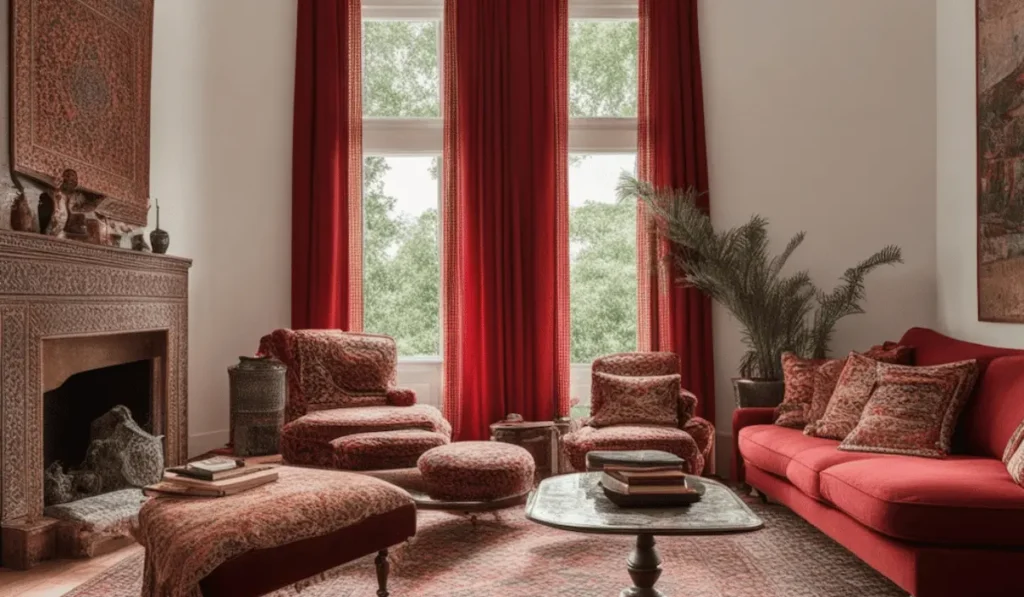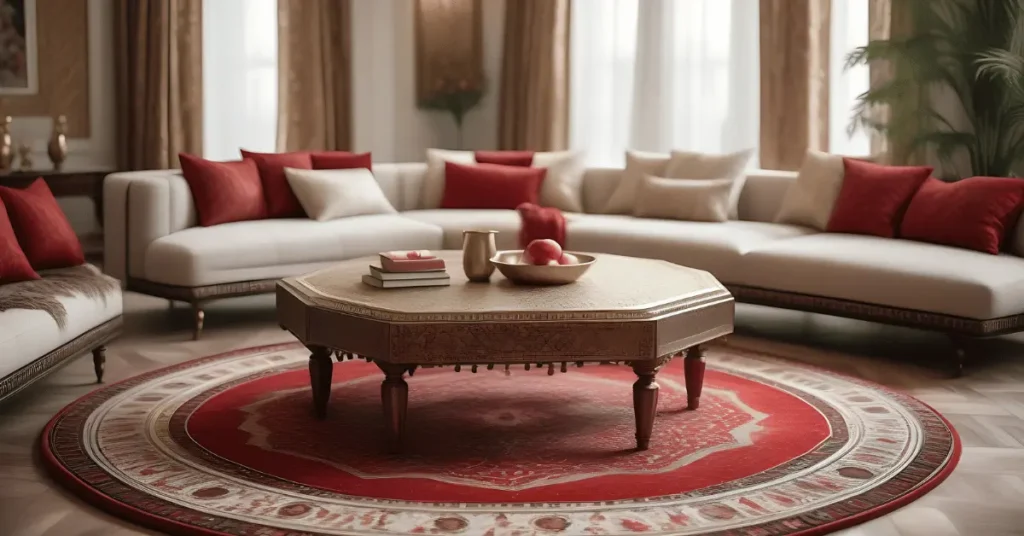How To Decorate A Middle Eastern Living Room
Updated: 17 April 2024
154
Any home’s living room serves as a central gathering place for family and guests, making it one of the most important rooms. A Middle Eastern living room design embraces the region’s rich culture and traditions. The purpose of this article is to explore common elements, decor ideas, and design principles for creating an inviting and authentic Middle Eastern living room.
A Middle Eastern-Inspired Living Room
The Middle Eastern style can be incorporated into a living room design by drawing inspiration from key regions. Nods to Morocco, Turkey, or other areas add even more richness to texture, pattern, and tradition. Moroccan stripped lamps and Turkish kilim pillows add authentic flair. A global eclectic vision is achieved by incorporating stylistic accents from various countries within an overarching Middle Eastern design aesthetic.
Middle Eastern Living Room Furniture

In a Middle Eastern-inspired living room, sectional sofas invite conversation. Add pouf ottomans and floor cushions in velvet, leather, and embroidered fabrics to complete the look. Guests are welcomed by low coffee tables with ornate inlays, while open shelves provide plenty of display space. The furniture is arranged by concept with seated areas, casual lounging nooks, and plant vignettes to encourage exploration. Turkish or Ottoman-inspired sofas accented by cushions offer layered texture that is approachable.
Middle Eastern Design Ideas and Inspiration
Comfort, luxury, and ambiance are the hallmarks of Middle Eastern design. Archways, domes, hand-carved details, mosaic tiles, and ornate plasterwork are common features of Islamic architecture. Warmth is provided by natural materials such as stone, wood, and textiles. Middle Eastern living room design ideas include:
- Incorporate arched doorways, niches, and vaulted ceilings to mimic mosques, palaces, and courtyards.
- You can use zellige tiles with geometric, arabesque, or floral motifs for flooring or backsplashes.
- Add visual interest to walls and ceilings with decorative plaster molding, medallions, and sculpted details.
- Make use of natural textures such as hand-woven rugs, tapestries, wood accents, and raw or polished stones.
- Furniture, art, and soft furnishings should incorporate organic shapes inspired by plants and flowers.
- Highlight architectural details and artwork after sunset with recessed lighting, wall sconces, or standing lamps.
- A neutral palette combines tans, taupes, creams, and muted jewel tones for an understated elegance. A vibrant pop of color adds contrast.
Living Room Furnished with Red Middle Eastern Rug

The living room’s centerpiece is a vibrant red Moroccan rug. It anchors conversation areas beneath a circular coffee table and accent chairs covered in kilim patterns. This rug becomes a casually welcoming lounge when layered with tasseled poufs and bolster pillows. Against an open shelving unit flanked by lithe brass bookends, art objects complement the rug’s dynamic star-and-line motif. In this tailored yet eclectic space, subtle track lighting highlights architectural details and wall sconces keep corners aglow.
Middle Eastern Interior Design Ideas
The following key interior elements help create an authentic look in a Middle Eastern living room:
- Incorporate plush sofas, poufs, and floor cushions around low tables for lounging and entertaining guests. Choose materials like leather, velvet, silk, and handwoven fabrics.
- The focal point of the room should be a statement rug, preferably flatweave in distinctive patterns. Size it large enough for multiple seating areas.
- Select a solid wood coffee table that is rectangular or round in shape and sized lower to the ground. Tradition is enhanced by carved or inlaid tabletops.
- Display decorative objects, books, family photos, and accessories on open shelving made of wood, stone, or metal. Built-in storage is provided by niches and alcoves.
- The various zones are decorated with accents such as pillows, blankets, trays, lanterns, plants, and art objects. It is common to find brass, pottery, glassware, and woven baskets.
- Make the most of natural light by framing oversized windows with plantation shutters or sheer curtains. Nighttime ambiance is provided by skylights.
- Incorporate overhead fans, portable units, or central air/heat in order to ensure guests’ comfort.
- Furniture should be positioned along the perimeter of the room with plenty of open space in the center for conversations and activities.
Middle Eastern interior design components ensure your living space feels both relaxing and authentically representative of the culture. You can create a room that transports you to the region by selecting the right materials, arranging them carefully, and styling them accordingly.
Ideas for Middle Eastern Decor

Decorate a Middle Eastern living room with these key regional motifs and pieces:
- To add visual interest, recreate arched entryways, stained glass accents, brass fixtures, and tilework.
- For your floor coverings, choose flatweaves or ornate Persian/Turkish rugs with repeating patterns. Oriental rugs add color and texture.
- Adding accent pillows to ottoman sofas and sectionals provides comfortable seating. Floor cushions provide seating on the floor.
- You can get wood coffee tables with carvings, inlays, or mosaics, as well as console tables with marble tops.
- Original Middle Eastern art, paintings, framed wall hangings, mirrors, and decorative tiles are available.
- Use brass, pewter, or glass candelabras, hanging pendant fixtures, and table & floor lamps.
- Windowsills and hanging planters can be decorated with palms, ferns, snake plants, and herbs like jasmine.
- Throw pillows, tapestries, woven curtains, and kilim spreads are all textiles.
- Brass trays, vases, incense burners, bronze urns, and decorative boxes.
- Nature can be brought indoors through soft green plants like palms, ferns, snake plants, or herbs like jasmine.
With the right color palette, patterns, and materials, your space will feel authentically Middle Eastern. Embrace regional inspirations when creating art.
Ideas for Middle Eastern Home Decor
Middle Eastern living rooms often feature the following decor ideas:
- Instead of dedicated living room furniture, arrange colorful floor cushions in conversational groupings.
- To accommodate folded legs beneath seated guests, choose wooden coffee tables that are of a lower height, often octagonal or round in shape.
- To create visual impact and comfort underfoot, place a large, beautifully patterned flatweave or Persian rug in the center of the room.
- Decorate upholstered pieces and floor cushions with pillows in a variety of fabrics, sizes, and embroidered patterns.
- For ambient, decorative lighting, suspend brass or glass lanterns from the ceiling on long chains.
- Decorate your walls with imported tapestries, framed photographs, decorative mirrors, art, and carved woodwork.
- Plant Life – Display palms, ferns, pothos, and other easy-to-care greenery indoors to represent growth.
- For a lived-in elegance, store blankets, board games, and magazines in woven rattan or seagrass baskets.
- Decorate the room with accent furniture such as low tables, ottomans, bookcases, and console cabinets.
- The key to creating an inviting, authentic space is to incorporate iconic Middle Eastern elements. You can make it cozy and visually appealing at the same time.
Middle Eastern Living Rooms Decor

Middle Eastern-style living room decorating ideas:
- Use plush ottomans or sectional sofas instead of standalone couches for flexible seating arrangements that can easily accommodate extra guests. Embroider silk or velvet in sumptuous fabrics.
- Stain or paint wood coffee tables with Mother of Pearl, brass, or mosaic inlays. The best shapes are low, rounded, or octagonal.
- Decorative elements such as archways, stained glass accents, ornate plaster medallions, or faux tile panels on walls add an air of richness and detail.
- Rugs Make the room’s centerpiece a large, flatweave rug with repeating patterns. For seating areas, add oriental runners or kilim spreads.
- Display original Middle Eastern tapestries, paintings, mirror mosaics or woven tapestries along empty walls.
- Soft pouf ottomans with embroidered exteriors provide additional seating around the coffee table or as floor cushions.
- Brass or glass tables and hanging lanterns provide ambient lighting. Along empty walls, place wall sconces.
- For windowsills, pot palms, ferns, or pothos. Display shell bowls, stacks of books, and potpourri-filled woven trays.
- With these carefully curated decorative items, your living space will achieve an inviting, authentically Middle Eastern ambiance. Make your selections according to your preferences.
Middle Eastern Living Room Decorating Ideas
To help you bring the style to your living room, here are some additional Middle Eastern decorating ideas:
- At night, hang ornate brass lanterns from the ceiling to illuminate the room. Tradition and warmth are added by them.
- As a visual focal point, place a decorative tray on the coffee table filled with books, candles, coasters, and other accessories.
- A light, muted color like pale blue or tan can be used as a backdrop for billowing voile curtains.
- To mimic architectural features seen throughout the region, install frosted glass doors or decorative lattice panels.
- Establish vignettes with authentic artwork, mirrors, or photos on walls that have not yet been decorated.
- The thicker the fold, the better
Conclusion
To create a welcoming sanctuary for family and guests, Middle Eastern living room design incorporates iconic architectural features, luxurious materials, and eclectic artisanal accents. An authentic yet livable space is achieved by prioritizing lounging areas, focal art and rugs, soft textures, natural lighting, and well-considered decorative flourishes. You can transform your living room into a peaceful oasis reflecting Middle Eastern culture and traditions by drawing inspiration from regional influences. Personalize the aesthetic through color palettes, artwork selections, and styling that resonate with you.
FAQs
Q1. In a Middle Eastern living room, what kind of furniture is typical?
A: Sectional sofas, pouf ottomans, floor cushions, low coffee tables, arched wood consoles, and open shelving units are common furniture pieces.
Q2. Typically, what type of rug is used?
The most authentic rugs are flatweaves and Persians with vibrant, repeating patterns. It is also possible to use kilims, oriental rugs, and Turkish rugs.
Q3. How are seating arrangements usually arranged?
Middle Eastern living rooms feature flexible, casual seating arranged in conversational groups. It can include sofas, floor cushions, and poufs facing each other.
Q4. Is there a particular style of lighting that is popular?
A: Common lighting fixtures include brass standing lamps, mosaic table lamps, and wall sconces. Lighting for ambient purposes is more important than lighting for task purposes.
Q5. Are there any plant varieties that thrive?
The easiest indoor plants to care for are palms, snake plants, ferns, and herbs such as jasmine. The often hot, arid interiors are also ideal for succulents.
Q6. Can architectural elements be replicated?
A: Regional design elements include niches, mirror mosaics, faux plaster molding, stained glass accents, and decorative tilework.
Q7. Typically, what color palette is used?
Earthy neutrals like tans, creams, taupes, and moody jewel tones are popular. Vivid blues, reds, and greens are used as accents.
Q8. How should I treat my windows?
Light can be let in through billowy sheer curtains, plantation shutters or linen shades while privacy is maintained. Fabrics that are dark and heavy should be avoided.
Q9. Which Middle Eastern accessories are iconic?
Trays, lanterns, pottery, coffee table books, decorative boxes, framed artwork, wall hangings, and woven baskets.
Q10. Is it possible to customize the style?
Choose furnishings, artwork, finishes, and colors that reflect Middle Eastern traditions, while still reflecting your individual tastes.
Please Write Your Comments